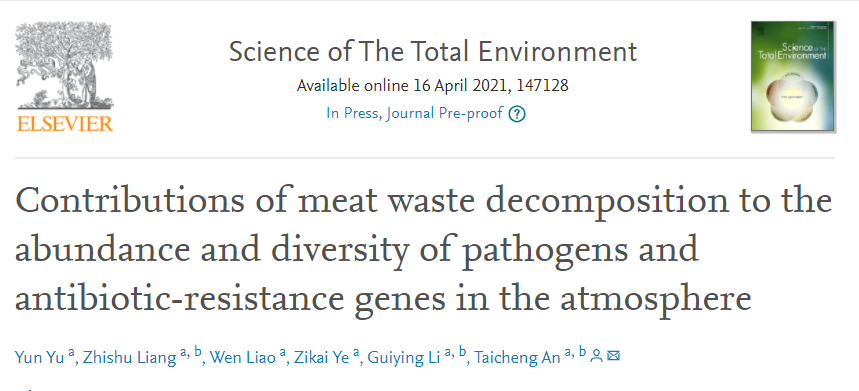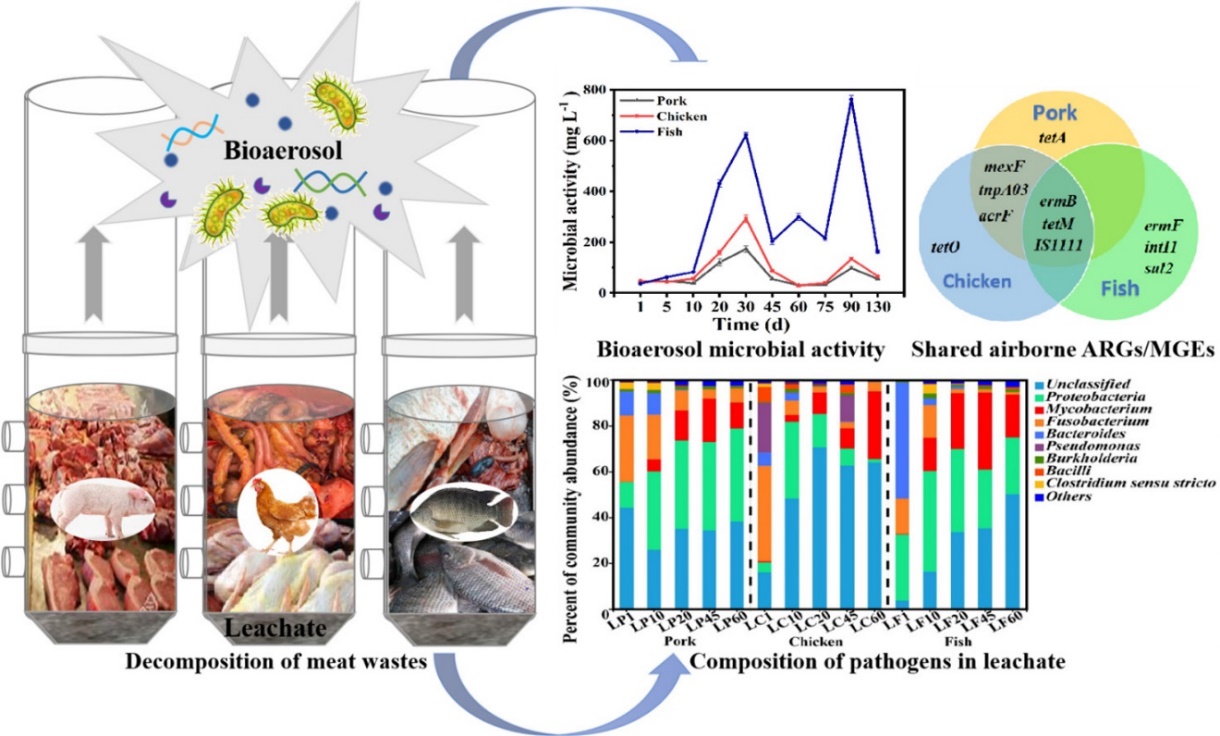近日,广东工业大学环境健康与污染控制研究院、环境科学与工程学院安太成教授团队的题为《Contributions of meat waste decomposition to the abundance and diversity of pathogens and antibiotic-resistance genes in the atmosphere》的学术论文在Science of the Total Environment(STOTEN,https://doi.org/10.1016/j.scitotenv.2021.147128)杂志上发表。论文的第一作者为硕士研究生余昀,通讯作者为安太成教授。该研究首次从微生物气溶胶浓度及粒径分布、总微生物活性、细菌群落结构演变、抗生素耐药基因/可移动遗传元件(ARGs/MGEs)动态分布等多个角度,全面阐述了生活垃圾分解过程生物气溶胶的释放特征以及细菌群落在不同环境因素下和作为潜在宿主驱动ARGs在MGEs介导下的耐药性传播,该研究不仅有助于加深对城市生活垃圾分解过程中生物气溶胶化行为和抗生素耐药性的了解,而且也可以为生活垃圾厌氧分解过程的健康风险评估与控制提供参考。

论文DOI: https://doi.org/10.1016/j.scitotenv.2021.147128
垃圾填埋场中气载抗生素耐药基因(ARGs)和致病菌耐药性的获取对人类和环境健康构成潜在威胁。然而,人们对生活垃圾填埋过程中释放到空气中ARGs和致病菌的贡献知之甚少。本研究通过构建生物反应器以模拟各种肉类垃圾的发酵,对比研究了鸡、鱼和猪肉垃圾分解过程中生物气溶胶的形成和释放特征,对发酵渗滤液和生物气溶胶中微生物群落和ARGs的动态变化进行了详细的比较研究。结果发现:鸡肉和猪肉的分解可能导致散发出大量的生物气溶胶和致病菌,而鱼肉的分解则会导致较高水平的空气微生物活性,并且具有最高比例的可吸入性粒子,呈现出较高的气溶胶暴露风险。生物气溶胶中的优势致病细菌是Bacilli,Burkholderia-Paraburkholderia,Mycobacterium,而渗滤液中的Wohlfahrtiimonas,Peptoniphilus,Fusobacterium占优势地位,渗滤液中细菌气溶胶化的能力并不完全依赖于它们的丰度和多样性。相比之下,渗滤液中ARG的多样性和相对丰度明显高于生物气溶胶中,但是渗滤液和生物气溶胶中ARGs的相对丰度并无显著相关。生物气溶胶中存在着耐药性的水平转移和环境扩散,ARGs可能会通过MGEs进行水平转移,表明生物气溶胶和渗滤液中ARGs的演替很大可能是由细菌宿主的变化所驱动的,因为ARGs/MGEs才是影响细菌菌群结构的主要因素。综上,我们的研究认为,我们必须加强对生活垃圾分解过程中生物气溶胶的暴露风险认识,聚焦于控制耐药性生物气溶胶扩散等问题。
项目资助:本研究受到国家自然科学基金项目(U1901210, 41877363, 41807405);广东省自然科学基金项目(2019A1515010599);广东省珠江人才计划地方创新团队项目(2017BT01Z032)的资助。
Graphical Abstract:

论文英文摘要
Airborne transmission of antibiotic-resistance genes (ARGs) in landfill and acquisition of antibiotic resistance by pathogenic bacteria are posing potential threat to human and environmental health. However, little is known about contribution of waste decomposition to airborne ARGs and pathogens during landfilling of household waste. Herein, the dynamic changes of microbial communities and ARGs were comparatively investigated in leachate and bioaerosol during the decomposition of chicken, fish, and pork wastes. Results found that chicken and pork decomposition could result in emitting high abundance of bioaerosol and pathogen, while fish fermentation will lead to high airborne microbial activity. The main pathogens were Bacilli, Burkholderia-Paraburkholderia and Mycobacterium in bioaerosols, but were Wohlfahrtiimonas, Peptoniphilus and Fusobacterium in leachate, suggesting that the ability of aerosolization of bacteria in leachate was independent of their abundance and diversity. Whereas, diversity and relative abundance of ARGs in leachate were significantly higher than bioaerosol. Moreover, the relative abundance of ARGs in leachate and bioaerosols was not completely relevant. The changes of pathogenic community contributed significantly to the prevalence of ARGs in bioaerosol and leachate. The results will define the contribution of household waste decomposition to airborne pathogen and ARG distribution and provide foundation for airborne bacterial exposure risk and control in landfill.